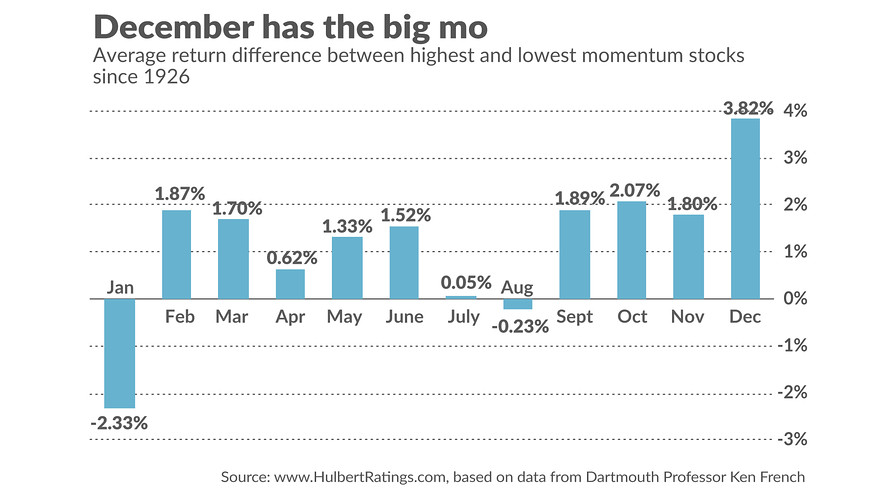December is the best month in which to bet that the stock-market’s winners will keep on winning. And for the losers to keep on losing.
I’m referring to the so-called momentum effect in the U.S. market, which is the tendency for the stocks that have performed the best over the trailing year to outperform those with the worst returns. While this effect is well-known on Wall Street, investors are less aware that it is most powerful in December.
Consider two portfolios, one equally divided among the 10% of stocks with the highest trailing returns (the “winners” portfolio) and the other containing the 10% of stocks with the worst (the “losers” portfolio). These portfolios are rebalanced monthly. Since 1926, according to data from Dartmouth University finance professor Kenneth French, this winners portfolio beat the losers portfolio by an average of 0.93% during the first 11 months of the year.
Not bad, but for the month of December, as you can see in the chart below, the outperformance of the winners is more than four times greater — 3.82%. This difference is significant at the 95% confidence level that statisticians often use when determining whether a pattern is genuine.

What this means: Assuming the future echoes the past, you should favor the past year’s best-performing stocks in any year-end trades. If you’re making a longer-term bet on momentum strategies, you probably will want to place your bets now rather than wait until the New Year.
That’s because, as the chart shows, January typically experiences a significant reversal of the momentum effect. Now it’s the trailing year’s worst performers to have their day in the sun, significantly outperforming the best performers.
Why would December exhibit such strong momentum effects, and January just the opposite? The answer, according to research conducted by Richard Sias, chair of the finance department at the University of Arizona, traces to end-of-quarter “window dressing” and tax-loss selling.
Such strategic trading occurs when institutions (especially mutual funds) sell their losers towards the end of the year and buy more of their winning stocks — in order to get bragging rights in year-end reports for having owned the winners, and to avoid the embarrassment of having invested in losing stocks. Tax-loss selling, meanwhile, occurs when investors sell the stocks they’re holding at a loss in order to offset any capital gains on which they otherwise would have to pay tax.
Both factors cause buying in December to be concentrated on the recent past’s winners and selling to be concentrated on the losers. In January, both of these factors are removed, and stocks correct for this artificial year-end pressure.
For the record, here are the stocks that are among the 10% of S&P 500 SPX, +0.10% with the best year-to-date returns, and which are recommended by at least one of the top-performing newsletters I monitor:
• Apple AAPL, +0.01%
• Applied Materials AMAT, -1.27%
• FleetCor Technologies FLT, +1.86%
• General Electric GE, -1.47%
• Lam Research LRCX, +0.03%
• Masco MAS, +1.06%
• NVIDIA NVDA, -1.25%
• Qorvo QRVO, -0.16%
• Seagate Technology STX, -0.22%
• Synchrony Financial SYF, -0.32%
• Target TGT, +1.83%
• Tyson Foods TSN, +0.14%
• Western Union WU, -0.05%
Mark Hulbert is a regular contributor to MarketWatch. His Hulbert Ratings tracks investment newsletters that pay a flat fee to be audited. He can be reached at [email protected]
div > iframe { width: 100% !important; min-width: 300px; max-width: 800px; } ]]>






